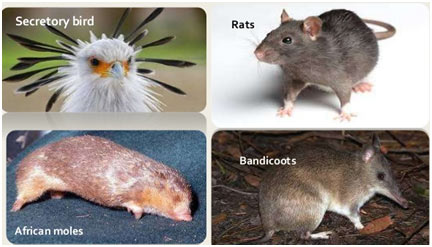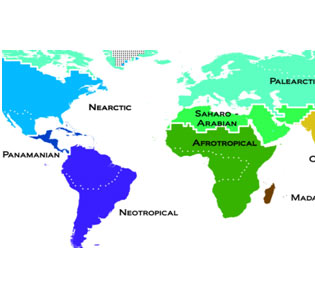Ethiopian Region
In this article, we will discuss the zoogeographical realm – the Ethiopian region, its physical features, climatic conditions, and zoological characteristics.
Extent
Ethiopian region consists of the whole of Africa except for its northern part which is the part of the Palaearctic region, and the southern part of Arabia. Some authors include the large island of Madagascar and its surrounding neighboring islands in the Ethiopian region.
Geographically and geologically, Madagascar is very distinctive and has different zoological characteristics from the Ethiopian region. So, it is treated separately from Continental Island.
East African subregion
This region has high temperatures and desert conditions. This consists of Tropical Africa and Tropical Arabia and the Sahara Desert. It has common desert animals such as camel, ostrich, zebra, etc.
West African subregion
This region has thick forests, therefore, received heavy rainfall which nourishes flora. Good flora supports a variety of fauna which includes elephants, lions, gorillas, gibbons, etc. river Congo is also part of this region.
South African subregion
This region is also included in the Ethiopian region. It has some peculiar fauna which includes African lungfish, African mole, rats, etc.
Malagasy subregion
The evolution of the Ethiopian region developed lemurs in Madagascar and thus separated it from the mainland. There is no connection and are many dissimilarities in the fauna of both regions. Now it is treated as another Continental region.
This subregion includes Madagascar and neighboring islands. There are no new animals. Here the fauna is represented by old animals. Some eutherians invaded this region. Lemurs and Chameleons are famous in this region.
Physical features and Climatic conditions
Almost all sides of this region are surrounded by the sea except for the northern side which is the Sahara Desert. The Sahara Desert is the largest desert in the world and acts as a barrier between Palaearctic and Ethiopian regions.
African is region is present in between tropics, here life conditions are much more uniform. This region contains thick, dense forests, high mountains, grassy plains, and big rivers. In January the whole region has a temperature of somewhat between 20 to 30 ᵒC with a still higher temperature in Central Africa.
Moisture conditions affect the distribution of plants and animals more than temperature. The great diversity of flora here supports a variety of endemic fauna.
Zoological Characteristics

The Ethiopian region has very rich fauna which also varies greatly and well-marked. This region contains as many as 161 families of terrestrial vertebrates out of which 12 families are exclusive to this region.
Mammals:
There are 38 families of mammals out of which 12 are endemic to this region. These endemic families include:
Hippopotamidae (hippopotamus), Chrysochloridae (golden mole), Orycteropidae (Aardvarks), Anamoluridae (flying squirrels), Giraffidae (giraffe), Pedetidae (spring Hares), Macroscelidae (elephant shrews), Potamagolidae (otter shrews), Petromuridae (rock rats), Thyronomydae (cane rats), Ctenodactylidae (Gundis), Bathyergidae (sand burrowing rodent).
The animals which it shares with the oriental region are monkeys, pangolins, lorises, Cheetahs, rhinoceroses, etc. This region also shares few animals with the Palaearctic region which are wild horses, jerboas, and dormice.
Aves:
Birds are very numerous. There are six families of birds that are endemic to this region. These are ostriches, secretary birds, helmet shrikes, mousebirds, hammerheads, and crested touracos.
The birds which it shares with the Oriental region are cuckoos, hornbills, woodpeckers, bee-eaters, kingfishers, orioles, owls, goatsuckers, storks, pigeons, etc.
Reptiles:
Here reptilian fauna is very rich. Out of 50 total species of Chameleons in the world, 46 are present in this region. Crocodiles, turtles, agamids, monitor lizards are also found in this region. Girdled lizards are exclusive to this region.
Amphibians:
Amphibians are less distinctive in this region. There are numerous toads and frogs but no urodeles are present. There are no tailed amphibians and tree frogs in this region. The only endemic family to this region is Dactylethridae represented by the genus Xenopus; the clawed toad.
Fish:
The fish fauna of the Ethiopian region is diverse and consists of many primitive groups such as polypterus (Bichir), protopterus (lungfish), mormyrids, etc. There are two species of lungfish in the rivers and lakes of this region.
Ten species of Bichir are found here. Electric eels, carps, catfishes are also present.
Affinities to other regions
It ranks second after the Neotropical region in having a great number of unique families of fauna. Ethiopian region shares some families like jerboas, wild horses with the Palaearctic region. It shares eight mammalian families with the Oriental regions such as lorises and monkeys.
There are no common mammals which it shares with Neotropical and Nearctic regions. The Ethiopian region resembles both the Neotropical and Oriental regions in fish and reptilian fauna. So, it can be said that the Ethiopian region resembles mostly with Neotropical and Oriental regions.
It is because they all have tropic climatic conditions but their similarities are much stronger with the tropics of the Old-world than that of the New World.
MCQs
- 1. Which of the following is NOT included in the Ethiopian region?
- A) Madagascar
- B) Southern Arabia
- C) Sahara Desert
- D) Northern Europe
- Answer: D) Northern Europe
- 2. What distinguishes the Malagasy subregion from the mainland Ethiopian region?
- A) Similar fauna
- B) Connection with the Palaearctic region
- C) Presence of lemurs
- D) High rainfall
- Answer: C) Presence of lemurs
- 3. Which subregion of the Ethiopian region has thick forests and heavy rainfall?
- A) East African
- B) West African
- C) South African
- D) Malagasy
- Answer: B) West African
- 4. What acts as a barrier between the Palaearctic and Ethiopian regions?
- A) Himalayas
- B) Amazon Rainforest
- C) Sahara Desert
- D) Atlantic Ocean
- Answer: C) Sahara Desert
- 5. How many families of terrestrial vertebrates are found in the Ethiopian region?
- A) 100
- B) 134
- C) 161
- D) 200
- Answer: C) 161
- 6. Which of the following families of mammals is NOT endemic to the Ethiopian region?
- A) Hippopotamidae
- B) Giraffidae
- C) Canidae
- D) Ctenodactylidae
- Answer: C) Canidae
- 7. How many species of Chameleons are found in the Ethiopian region?
- A) 40
- B) 46
- C) 50
- D) 60
- Answer: B) 46
- 8. Which of the following amphibian families is endemic to the Ethiopian region?
- A) Bufonidae
- B) Ranidae
- C) Dactylethridae
- D) Hylidae
- Answer: C) Dactylethridae
- 9. What distinguishes the avian fauna of the Ethiopian region?
- A) Absence of flightless birds
- B) Presence of penguins
- C) High diversity of parrots
- D) Dominance of aquatic birds
- Answer: C) High diversity of parrots
- 10. Which of the following fish groups is NOT found in the Ethiopian region?
- A) Lungfish
- B) Bichir
- C) Piranhas
- D) Electric eels
- Answer: C) Piranhas
- 11. What is the primary characteristic of the physical features of the Ethiopian region?
- A) Surrounded by mountains
- B) Lush rainforests
- C) Mostly covered by sea
- D) Sahara Desert in the north
- Answer: D) Sahara Desert in the north
- 12. Which region shares affinities with the Ethiopian region in terms of its fauna?
- A) Neotropical
- B) Nearctic
- C) Palearctic
- D) Oriental
- Answer: D) Oriental
- 13. What distinguishes the South African subregion in terms of its fauna?
- A) Presence of desert animals
- B) Abundance of lemurs
- C) Peculiar fauna like African lungfish
- D) Connection with the Palaearctic region
- Answer: C) Peculiar fauna like African lungfish
- 14. How many families of birds are endemic to the Ethiopian region?
- A) 3
- B) 4
- C) 5
- D) 6
- Answer: D) 6
- 15. What is the distinguishing feature of the Ethiopian region’s climate?
- A) Extreme cold temperatures
- B) Lack of rainfall
- C) Consistency in life conditions
- D) High altitude mountains
- Answer: C) Consistency in life conditions
- 16. Which of the following is NOT a characteristic of the East African subregion?
- A) Desert conditions
- B) High temperatures
- C) Thick forests
- D) Presence of desert animals like camel and ostrich
- Answer: C) Thick forests
- 17. What is the primary distinguishing factor between the Ethiopian region and the Palaearctic region?
- A) Similar climate
- B) Presence of lemurs
- C) Connection with other continents
- D) Sahara Desert acting as a barrier
- Answer: D) Sahara Desert acting as a barrier
- 18. Which of the following is NOT a characteristic of the Malagasy subregion?
- A) High rainfall
- B) Connection with the mainland
- C) Presence of lemurs
- D) Distinctive fauna
- Answer: B) Connection with the mainland
- 19. How many species of lungfish are found in the rivers and lakes of the Ethiopian region?
- A) One
- B) Two
- C) Three
- D) Four
- Answer: B) Two
- 20. Which of the following families of mammals is endemic to the Ethiopian region?
- A) Canidae
- B) Bovidae
- C) Elephantidae
- D) Chrysochloridae
- Answer: D) Chrysochloridae
- 21. What distinguishes the South African subregion in terms of its fauna?
- A) Presence of desert animals
- B) Abundance of lemurs
- C) Peculiar fauna like African lungfish
- D) Connection with the Palaearctic region
- Answer: C) Peculiar fauna like African lungfish
Summary:
The Ethiopian Region, encompassing a significant portion of Africa, exhibits diverse physical features, climatic conditions, and zoological characteristics. Comprising East, West, and South African subregions along with the Malagasy subregion, it boasts a unique blend of ecosystems.
The East African subregion showcases desert conditions and high temperatures, while the West African subregion is characterized by thick forests and abundant rainfall. The South African subregion features peculiar fauna like the African lungfish. Madagascar and its neighboring islands form the Malagasy subregion, distinct from the mainland.
Geographically, the Ethiopian region is distinguished by its proximity to the Sahara Desert, which acts as a barrier between the Palaearctic and Ethiopian realms. The region’s tropical climate supports diverse flora and fauna, with moisture conditions playing a crucial role in distribution.
Zoologically, the Ethiopian region is rich and varied, boasting numerous families of terrestrial vertebrates. It is home to endemic mammalian families like Chrysochloridae and Giraffidae, alongside shared species with Oriental and Palaearctic regions. Birds, reptiles, amphibians, and fish contribute to the region’s biodiversity, with distinct species like the clawed toad and endemic bird families.
Affinities to other regions highlight connections with the Oriental realm, while distinct fauna and climatic conditions set it apart from Neotropical and Nearctic regions. Overall, the Ethiopian region stands as a testament to the rich diversity of life in the tropics, with strong ties to both Old-World tropics and unique endemic species.

